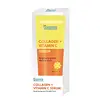What's inside
What's inside
 Key Ingredients
Key Ingredients

 Benefits
Benefits

 Concerns
Concerns

 Ingredients Side-by-side
Ingredients Side-by-side

Water
Skin ConditioningGlycerin
HumectantGlycereth-26
HumectantPropylene Glycol
HumectantHydrolyzed Collagen
EmollientAscorbic Acid
AntioxidantNiacinamide
SmoothingGlyceryl Polymethacrylate
Sodium Ethylparaben
PreservativePvm/Ma Copolymer
Emulsion StabilisingPolyacrylate Crosspolymer-6
Emulsion StabilisingPanthenol
Skin ConditioningCaprylhydroxamic Acid
Phenoxyethanol
PreservativeEthylhexylglycerin
Skin ConditioningMethylparaben
PreservativePEG-40 Hydrogenated Castor Oil
EmulsifyingParfum
MaskingWater, Glycerin, Glycereth-26, Propylene Glycol, Hydrolyzed Collagen, Ascorbic Acid, Niacinamide, Glyceryl Polymethacrylate, Sodium Ethylparaben, Pvm/Ma Copolymer, Polyacrylate Crosspolymer-6, Panthenol, Caprylhydroxamic Acid, Phenoxyethanol, Ethylhexylglycerin, Methylparaben, PEG-40 Hydrogenated Castor Oil, Parfum
Water
Skin ConditioningSodium Cocomonoglyceride Sulfonate
CleansingDecyl Glucoside
CleansingSodium Laureth Sulfate
CleansingCocamidopropyl Betaine
CleansingAcrylates/Steareth-20 Methacrylate Copolymer
PEG-120 Methyl Glucose Dioleate
EmulsifyingCocamide DEA
EmulsifyingPropylene Glycol
HumectantDisodium EDTA
Phenoxyethanol
PreservativeEthylhexylglycerin
Skin ConditioningCaprylhydroxamic Acid
Melaleuca Alternifolia Leaf Oil
AntioxidantAloe Barbadensis Leaf Extract
EmollientCalendula Officinalis Flower Extract
MaskingWater, Sodium Cocomonoglyceride Sulfonate, Decyl Glucoside, Sodium Laureth Sulfate, Cocamidopropyl Betaine, Acrylates/Steareth-20 Methacrylate Copolymer, PEG-120 Methyl Glucose Dioleate, Cocamide DEA, Propylene Glycol, Disodium EDTA, Phenoxyethanol, Ethylhexylglycerin, Caprylhydroxamic Acid, Melaleuca Alternifolia Leaf Oil, Aloe Barbadensis Leaf Extract, Calendula Officinalis Flower Extract
Ingredients Explained
These ingredients are found in both products.
Ingredients higher up in an ingredient list are typically present in a larger amount.
Caprylhydroxamic Acid is a chelating agent.
Chelating agents help prevent metal ions from binding to other ingredients. This helps prevent unwanted reactions and effects from using the product.
Caprylhydroxamic Acid is often used with natural antimicrobial products as an alternative to preservatives.
Learn more about Caprylhydroxamic AcidEthylhexylglycerin (we can't pronounce this either) is commonly used as a preservative and skin softener. It is derived from glyceryl.
You might see Ethylhexylglycerin often paired with other preservatives such as phenoxyethanol. Ethylhexylglycerin has been found to increase the effectiveness of these other preservatives.
Phenoxyethanol is a preservative that has germicide, antimicrobial, and aromatic properties. Studies show that phenoxyethanol can prevent microbial growth. By itself, it has a scent that is similar to that of a rose.
It's often used in formulations along with Caprylyl Glycol to preserve the shelf life of products.
Propylene Glycol is an odorless, colorless liquid. As a humectant, it helps skin retain moisture. It also aids in delivering active ingredients.
Another role of this ingredient is preventing a product from melting or freezing. Propylene glycol also adds antimicrobrial properties to a product, elongating product lifespan.
This ingredient is considered an organic alcohol and commonly added into both cosmetics and foods.
Those with sensitive skin or conditions may develop a rash when using this ingredient.
Learn more about Propylene GlycolWater. It's the most common cosmetic ingredient of all. You'll usually see it at the top of ingredient lists, meaning that it makes up the largest part of the product.
So why is it so popular? Water most often acts as a solvent - this means that it helps dissolve other ingredients into the formulation.
You'll also recognize water as that liquid we all need to stay alive. If you see this, drink a glass of water. Stay hydrated!
Learn more about Water